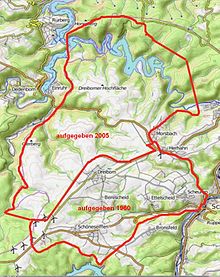Urft Dam
| Urft Dam | |
|---|---|
MW |
The Urft Dam (
The Urft Dam, which was constructed during the period 1900 to 1905, and the Urft Reservoir, which was then the biggest reservoir in Europe, having belonged since 1993 to the Eifel-Rur Water Board (Wasserverband Eifel-Rur).
Location


The Urft barrier system that comprises the Urft Dam and Urft Reservoir is located in the
Dam wall

The Urft dam is a curved gravity dam with its convex side facing upstream and an earth embankment (an Intze Wedge) on the reservoir side that reaches to about half the height of the dam wall. It is situated around 6.8 kilometres, as the crow flies, west-northwest of Gemünd, the northern part of the town of Schleiden in Euskirchen district.
The Urft Dam was built between 1900 and 1905. The overall plan for the dam was developed by Prof. Dr. Otto Intze from
On its completion, the Urft Dam became the model for many other projects at home and abroad after
North of the Urft Dam and separated from it by the base of a narrow peninsula is the spillway in the shape of an overflow weir with a maximum width of 91 metres which cascades down a total of 33 steps. Within the dam at an interval of 2.5 metres are vertical clay-filled tubes that drain away the water that seeps into the dam wall.
Several bottom outlet towers provide access to inspection walkways at two different depths that enable the state of Urft Dam to be checked. The lower inspection gallery runs along its base joint. From 1994 to 2000 the barrage was thoroughly renovated. Among other things, a problem with the uplift pressure was resolved. It was also given two new inspection galleries that were driven using
The Eifel-Rur Water Board celebrated the 100th anniversary of the opening of the Urft Dam on 26 August 2005.
Since the Rur Dam was completed, the Urft dam not only impounds water on its upstream side, but also impounds the waters of the Rur Reservoir (also called the Obersee) on its downstream side up to a depth of 12 metres.
Reservoir


The Urft Reservoir (Urftstausee or Urftsee), which when full is 7.85 km long according to the Deutsche Grundkarte map, although the straight-line distance from the head of the lake to the dam is only about 3.9 km), has a total area of 2.16 km2 and holds up to 47.75 million cubic metres of water. The
At the northwest end of the snaking waters of the Urft Reservoir and just below the Urft Dam is the Obersee lake, which acts as the main pre-basin for the Rur Reservoir and in which both the Rur and the Urft are impounded. In the Urft Reservoir (322.5 m above sea level (NN)), which is surrounded by wooded countryside, lies the island of Krummenauel (max 339.6 m above NN). The peninsulas at Altenberg (Auf dem Altenberg; max. 351.5 m above NN), Neffgesberg (max 370 m above NN) and Hosterauel (max 366.7 m above NN) jut out into the lake. They can also be reached on foot depending on the water level.

See also
- List of dams in Germany
- List of reservoirs by volume
Literature
- Talsperren in der Bundesrepublik Deutschland, Peter Franke, Wolfgang Frey, DNK – DVWK 1987, ISBN 3-926520-00-0
References
External links
- Information about the Urft Dam by the Eifel-Rur Water Board
- Data sheet by the Eifel-Rur Water Board (pdf file)
- Urft Reservoir water level gauge
- Dams of the Eifel
- NRW dam information (pdf file)
- Dams in North Rhine-Westphalia; Landesumweltamt NRW
- Constructionof the Urft Dam with history and photographs
